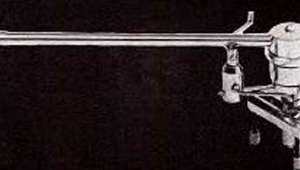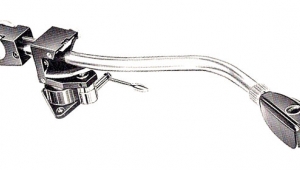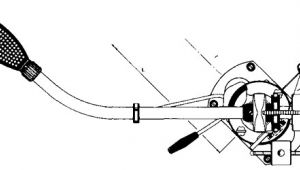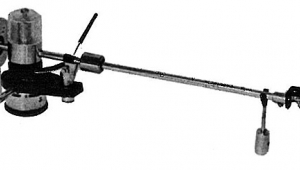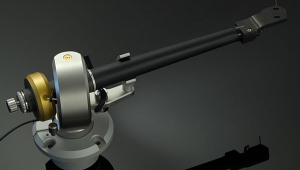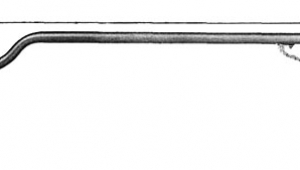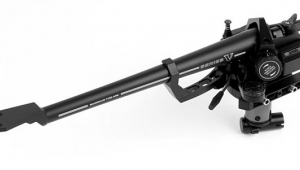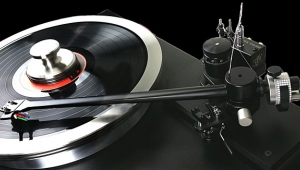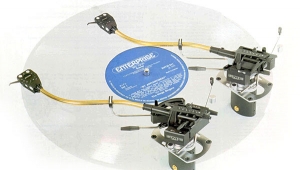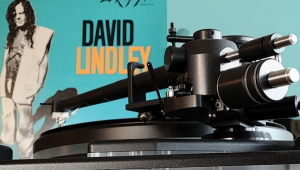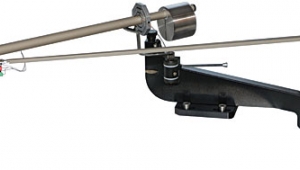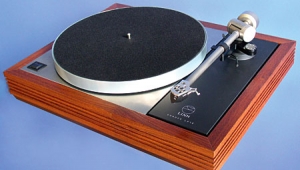| Columns Retired Columns & Blogs |
The Well-Tempered Arm
Remember Rube Goldberg? He was a cartoonist during the late 1920s to early 1950s who specialized in devising the most outlandish and ingenious devices ever conceived by man, before or since. A Rube Goldberg mousetrap, for example, would occupy an entire small room. In taking the bait, the mouse would tip a balance beam, dropping a steel ball into a gutter, down which the ball would roll to strike a paddle whose spin would wind up a string that hoisted a weight into the air until it reached a trigger at the top, which would then release the weight to drop onto the unsuspecting mouse. Splat!
Footnote 1: Sorry, I just couldn't resist that.—J. Gordon Holt
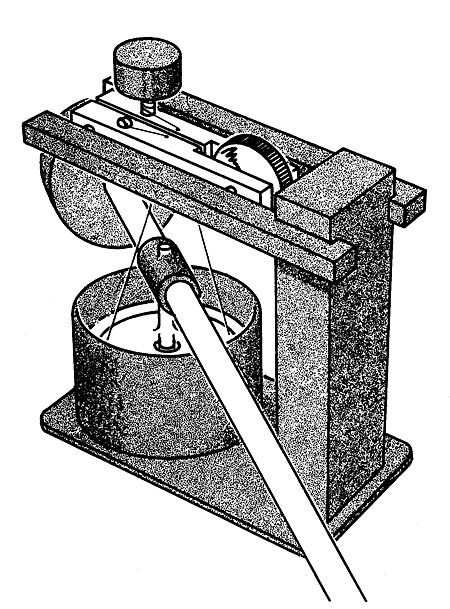
You get the idea? Well, the memories of those of us who remember Goldberg's drawings in the Sunday comics were stirred by our first glimpse of the Well-Tempered Arm's strings, paddles, and knobs. This is certainly the most outlandish contraption that has ever Graced (footnote 1) a SOTA or VPI turntable. Rube Goldberg, meet WTA designer William Firebaugh!
To begin with, this pivoting arm has no pivots. The arm is suspended, from an overhanging frame, at the ends of two short lengths of nylon monofilament (fishing leader). For all intents and purposes, the "pivoting" is absolutely frictionless. That's a good start.
These lines are not even attached to the arm itself, but to opposite edges of a 1¾" diameter metal disc from whose center rises a thin metal column that the arm proper is attached to. But that's not all. This disc is suspended about ¼" above the bottom of an upturned cup full of silicone damping fluid. That's another step in the right direction, because viscous damping is still the best system that has been devised for stabilizing tonearm behavior.
At the top of the suspension frame are two small parallel metal strips with two tiny holes drilled right next, to one another. The monofilaments supporting the ann pass through these holes. A vernier thumbscrew next to the holes adjusts the spacing between the strips; with the strips closest together, the spacing between the thread holes is so small that the ann is essentially suppcirtcd from a single point at the top. Like a single-thread support, this applies no force to the arm except that which counteracts gravity. But as the holes are moved farther apart (by turning the thumbscrew), the suspension becomes increasingly dual, and this, in conjunction with the weight of the arm, applies a twisting force that counters the direction in which the arm traverses the disc. The result is frictionless anti-skate bias.
At the top of the frame, one filament is anchored to a screw and the other wraps around the shaft of a small knob. Rotating the knob changes the length of one filament, raising that side of the damping disc and causing torsional rotation of the arm, to set azimuth. As you may begin to see, some real ingenuity went into the design of the WTA.
And there's more. This is one of the easiest of all tonearms to install. (Setup is another matter altogether.) It requires only a single 1/16" hole In the motor board. And that's it! Through that small hole passes a single long bolt, a ½" sleeve fits over this bolt, and the entire tonearm frame fits over the sleeve. The frame is free to slide up and down the sleeve until locked in place (at the desired height) by another knurled knob—VTA adjustment requires no tools, and can be carried out, with care, even while the record is playing!
The arm itself—apparently just a hollow cylindrical tube—is internally packed with, of all things, dry sand. This simple expedient has made it one of the most inert tonearms I have ever had the pleasure of tapping with a straightened-out paper clip. (With the stylus on a stationary discand the volume at normal listening, this is an effective, quick, and easy test for tonarm/cartridge coloration. The ideal sound is a featureless thunk. Clinks, clanks, or booms are a bad sign.)
The "headshell" is merely a small aluminum block with a single elongated hole in it (for overhang adjustment). The cartridge does not attach directly to this, but to a small metal strip, one end of which extends in a gentle curve to serve as a finger lift. The strip has two unthreaded cartridge-mount holes, with a third, threaded hole between them. The clip, with the cartridge attached, fits beneath the arm end block and is anchored in place by a single screw through the slotted hole in the block, thence into the threaded hole in the fingerlift strip. This single-point mounting also allows the cartridge to be rotated in the arm for final tangency adjustment before the fastening screw is tightened. More cleverness!
The electrical connections to the cartridge are made via unique (for tonearms) spring-loaded clips that will snugly fit almost any cartridge pins (footnote 2) without having to adjust for their diameter. Only someone who who has actually installed a cartridge himself can appreciate the value of these clips, as they eliminate what is undoubtedly the most disagreeable apect of the job: spreading or squeezing the clips to fit them to the cartridge pins (whose dimension has never, it appears, been internationally standardized). And the fact that one deosn't have to manhandle the clips means that they are far less likely to bring on an even more unpleasant situation: the detachment of a clip from its thin wire.
I have been wondering lately why it is that the Japanese, who have the best reputation for human engineering, have refused to apply that talent to phono cartridge installation. Such innovations must, apparently, come from the US.
Finally, Mr. Firebaugh has done yet another thing right. Instead of the usual big, fat, suspension-degrading cables coming out of the bottom of the arm, the WTA has a relatively short bunch of lightly twisted lightweight wires running from the arm's center of gravity to a small box with two RCA receptacles and a ground plug. A strip of double-backed adhesive tape allows this to be attached at the back of the turntable base (footnote 3), from which standard high-grade RCA-terminated cables can be run to the preamp inputs. This allows total utilization of the turntable's isolation capability, even on a lightly sprung table.
Final setup adjustment of the WTA is moderately easy, but does require some care and finickiness to gt everything just right. Arm height (and thus VTA) is adjusted in a fairly standard way: a set screw on the pillar is loosened and the whole assembly moved up and down. Overhang is adjusted cleverly and easily: The mounting post bolted to the turntable armboard has washers above and below the sleeve, on which the arm is actually mounted. This allows the sleeve to rotate in relation to the mounting post and, since the arm is mounted off-center, pivoting it changes the overhang (footnote 4).
Sound Quality
Now that I have just devoted over 1000 words to telling you how marvelously conceived and executed this thing is, do you really think I would report that it doesn't work very well? Well, I won't. I have gotten the best sound from more cartridges mounted in the WTA than from any other arm I have used. In fact, the WTA seems to have the amazing capability of making even the lousier moving coils sound acceptably good. It tames their rising high end to the point where the high end is only irritating rather than excruciating. Ah-ha! It softens highs, right? Well, yes; it seems to. But it causes no change in measured high end response.
When highs sound softer even when they measure the same, the change can only be due to the lowering or elimination of some HF distortion. That added softness has, in every case, made disc reproduction more tape-like and effortless (read: more natural) than it was. Even more interesting is that cartridges possessing a natural high-end balance, like the Shure V15-VMR or the Ortofon 2000, were virtually unaffected at the high end by the WTA.
The low end from most cartridges In this arm is just about perfect: extraordinarily deep, tight, and detailed, and very much on a par with that from digital sources (footnote 5). The amount of damping provided by the arm seems to be perfect, neither underdamping (giving more fullness but less detail) nor overdamping (tending to dry up the low end, making it very tight but sparse) most cartridges. In short, this has become my favorite and my reference standard tonearm (footnote 6). The added fact that near perfection in an arm now costs only $500 is even more reason to be enthusiastic about it.
Two final notes: First, Larry Archibald raised a question about the efficacy of that puddle of damping fluid in transmitting tonearm vibrations down to the motor board. Although I found no way of ascertaining this objectively (footnote 7), I can only say that the clarity and razor-sharp detail of this arm's sound does not suggest the presence of uncontrolled vibrations. Bill Firebaugh told me that the fluid's viscosity had been chosen to provide maximum vibration transmission down to about 20Hz, with increasing decoupling of the arm from the motor board below that, to allow the cartridge to track warps with the least possible flexing of the stylus. And this is, in fact, how the arm behaves.
Second, there is some question about the use of a (relatively) non-rigid arm tube and the lack of intimate, large-area contact between cartridge and headshell. All I can say is that the proof is in the hearing: the WTA passes this acid test better than any arm I have used.
The Well-Tempered Arm, then, is most highly recommended. In fact, if you don't own a Goldmund arm right now, and don't plan to sell your Texaco stock to buy one, the WTA is almost certain to dramatically improve the sound you get from discs.—J. Gordon Holt
Anthony H. Cordesman wrote about the Well-Tempered Arm in November 1985 (Vol.8 No.7):
A surprisingly neutral arm with great flexibility in coping with different cartridges, the WTA is ideal for Deccas and moving coils. Generally lacking in resonance and coloration. Dynamic, and with a slightly larger-than-life soundstage. Good detail, but not equal to the top super-rigid pivoting arms, or the Eminent Technology in resolving fine musical detail or harmonics.
Set-up is a bit complicated, but scarcely a problem for anyone who is literate and has half an hour. Very good value for money for the Decca or moving-coil lover who does not want to change cartridges often.—Anthony H. Cordesman
JGH returned to the Well-Tempered Arm in March 1986 (Vol.9 No.3):
Imagine: Never again having to adjust cartridge connecting clips to accommodate different cartridges! No more cursing, no more forcing on clips that are just a bit too tight, no more broken lead-wires...The ones Bill Firebaugh chose for this arm are a cinch to attach, and they are somehow able to provide a snug fit on the thinnest or fattest connecting pins. Why has no other tonearm manufacturer bothered to do anything this sensible?
That's just one of the things about this strange-looking arm that I have come to appreciate more and more. It does everything better than any other tonearm I know of, including effortless (and wow-less) tracking of the most appallingly warped discs.—J. Gordon Holt
Footnote 1: Sorry, I just couldn't resist that.—J. Gordon Holt
Footnote 2: The exceptions are those designed to fit P-Mount sockets, which are to thin to fit anything else.—J. Gordon Holt
Footnote 3: This is my only gripe about the WTA—the double-backed tape is not sticky enough to secure the box to the side of my table. Another solution is in order, but I haven't yet come up with it.—Larry Archibald
Footnote 4: In the years since JGH wrote these words, WT has improved the arm's adjustability even more. Arm height is now finely adjustable via an Allen wrench inserted into the top of the arm post. Damping, too, is easily and finely adjustable. The fluid cup is threaded—using very fine threads—into the arm base, so rotating the cup moves it vertically with respect to the suspended disc, thus varying the damping.—Brian Damkroger, August 1999
Footnote 5: A report from one of our contributors, who specializes in listening to music containing significant energy below 30Hz (his system is flat to roughly 16Hz), would have it that the WTA does not perform as well in this bottom octave as Sumiko's Arm ($1200), which sounds tighter and appears to have more level" below 30Hz. JGH's system does not exhibit this kind of low-end —nor do 98% of the systems out there.—Larry Archibald
Footnote 6: Using this arm for my cartridge evaluations may prove to be mistake in the long run, as it tends to make every cartridge sound smoother and cleaner than it would in practically any other arm.—J. Gordon Holt
Footnote 7: Readers' suggestions would be welcomed.—J. Gordon Holt
- Log in or register to post comments
